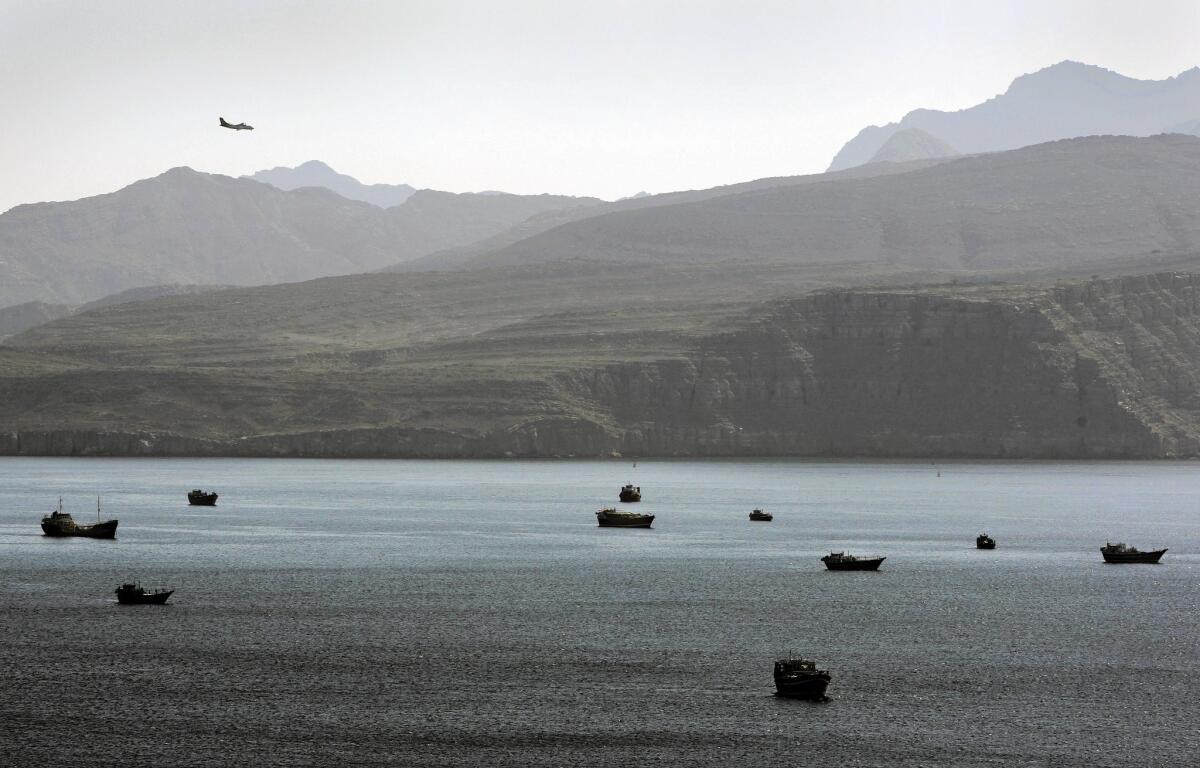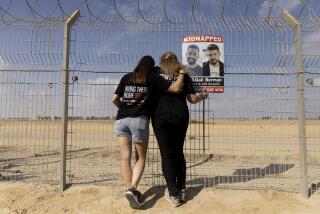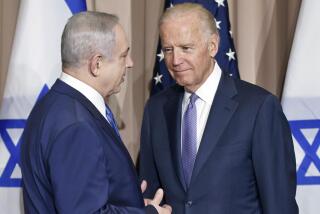Op-Ed: The Strait of Hormuz, an ancient tinderbox, still sits at the center of global conflicts

On July 19, Iranian forces using fast boats and helicopters seized the British tanker Stena Impero and its crew, including many Indian nationals, in the Strait of Hormuz. The British warship Montrose could not arrive in time to stop the nimble capture.
There are, in fact, many other forgotten incidents that could have made similar headlines. A cargo ship is heading for China from a rich Persian Gulf port, but it faces the threat of raids by bands of pirates hiding in the high mountain coves along the strait. There is a group on the gulf shore with plans to take over Mecca, steal the Black Stone and destabilize the whole Islamic world with their preaching and plunder. There are separatists from Baluchistan near the Hormuz. They attack a Portuguese ship washed up on a sandbar on the Persian coast. The British send the battleship Eden to the gulf after a Wahhabi âpirateâ attack on a ship leads to the killing of the South Asian crew. There are even reports of European female hostages being held captive in an undisclosed location.
These could all be plausible headlines in 2019. But only the first occurred in the most recent news cycle. The others are historical â evidence of the many centuries of conflict and insurgencies in the Strait of Hormuz, as well as efforts to pacify those threats.
Ships sailing to China from 9th century Siraf, a city on the Persian coast that was the Dubai of its day, had to traverse the perilous strait. The radical raiders of Mecca were not Al Qaeda or Islamic State but the Qarmatians. They took the Black Stone of Mecca, moving it to the gulf in A.D. 930. The Nautaques were Baluchis who traded and raided in the gulf, engaging in constant skirmishes there when the Portuguese tried to control commerce through the Hormuz from the 16th to the early 17th century. Around 1819, the British sent the Eden through the Hormuz to the gulf to root out piracy. In his log, Captain Francis Loch wrote about smaller local vessels near the strait running circles around him, a predicament similar to âasymmetric warfareâ that takes place today.
The British, confronting this chaos, eventually embraced a new strategy that would last well into the 20th century. They came to realize that simply attacking threats would never be enough to enforce security through the Strait of Hormuz, let alone throughout the Persian Gulf.
They knew that local actors, familiar with the shoals and desolate fjords in the gulf, could run circles around the bulky European ships built for Atlantic storms. But while those warships could not stop all piracy, they could hold parties on the shore responsible. To do that required building alliances and gathering intelligence.
In 1820, the British implemented this policy, which involved identifying specific partners or sheiks, individuals who would be held responsible for attacks from their territories. They also launched a major effort to understand both the geography of the gulf and the human and historical context of the region.
By 1853, the sheiks and Britain had signed the Perpetual Maritime Truce. Piracy declined dramatically. Over time, the British mapped the thousands of miles of obscure inlets and islands of the gulf and created a series of tomes called âThe Gazetteer of the Persian Gulf,â which was completed in the early 20th century and remains to this day an unparalleled resource for historians and even policymakers looking for explanations of the complex ties of the ruling families in the region. All of this came out of the need to secure trade through the Strait of Hormuz, which the British largely achieved from 1820 to 1970.
In the 1970s, as the colonial era ended, the British withdrew from the gulf. The Iranian revolution in 1979 overthrew the shah, a U.S. ally, split the gulf in two between Sunni Arab states and Iran, ruled by Shiite Muslim faqihs. The United States, wanting to protect the gulf and the Strait of Hormuz from a resurgent Iran and Soviet intervention, filled the gap left by British withdrawal.
In 1980, President Carter proclaimed the Carter Doctrine, stating that the U.S. would guarantee the security of commerce and oil through the Persian Gulf. During the 1980s and 1990s, the U.S. intervened over and over again â from securing shipping from Iranian threats in 1988 to protecting oil flows after Iraq invaded Kuwait in 1990.
The goal through the last several decades has been to prevent any state from completely dominating the gulf. In the 2000s, Sunni-ruled Iraq was taken out of that balance after the Iraq war. The Arab states, though largely relieved by the fall of Iraqi leader Saddam Hussein, also realized the need to defend against increased Iranian domination and influence.
The 2015 Iranian nuclear deal had the potential to keep nuclear conflict at bay. President Trumpâs abandonment of the pact, encouraged by Secretary of State Michael R. Pompeo, has now done severe damage to the security of the Strait of Hormuz, turning a chokepoint into a tinderbox.
But Trump made two good decisions, at odds with the position of senior officials like Pompeo and John Bolton, the national security advisor. He was right not to strike militarily against Iran after it shot down an American drone in June. He is also right to keep channels open to talks with Iran.
While the chances of a breakthrough are diminishing, it is still possible to stop a dangerous bluffing game. On the U.S. side, this would require a willingness to reopen negotiations with Iran on the nuclear deal. Iran and the its Islamic Revolutionary Guard Corps would also need to make specific concessions such as ending the enrichment of nuclear fuel to weapons-grade and putting a lid on its own threats to shipping in the Hormuz. Iranâs recent actions in the strait were reckless, though they may have been an attempt to gain leverage in possible future negotiations.
Perhaps more than any other Persian Gulf nation, Iran knows the long and difficult history of conflict on its shores. Its own oil terminal is at Larak Island in the Strait of Hormuz. No one, least of all the Iranians, would benefit should current tensions escalate to war.
Allen James Fromherz is a professor of history and director of the Middle East Studies Center at Georgia State University. He is the author of the forthcoming book âThe Global Gulf, a History.â
More to Read
A cure for the common opinion
Get thought-provoking perspectives with our weekly newsletter.
You may occasionally receive promotional content from the Los Angeles Times.










